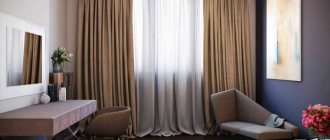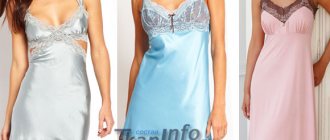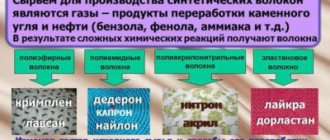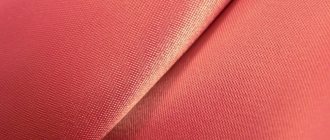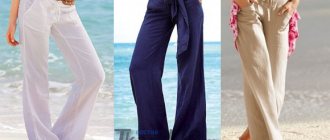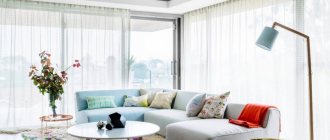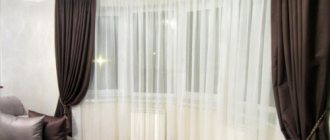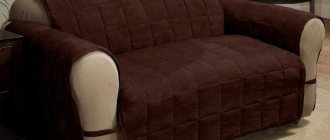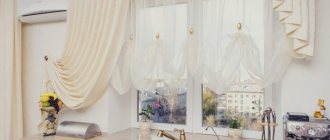Tulle is a fabric consisting of artificial threads with the addition of natural ones. It is made from silk, cotton, synthetics, and various fibers. Airy and flexible fabric is present on the windows of almost every home.
Its main characteristic feature is the ability to transmit sunlight while dispersing it, which is especially important in darkened rooms. With proper care and careful handling, curtains will last for many years.
Tulle fabric
What it is
Tulle is a type of mesh, that is, a material that contains cells of different sizes between the connected threads of the weft and warp. It got its name in honor of the French city where it was invented. Simple and colorless textiles were used for making clothes.
For your information! Previously, tulle fabric was produced only by hand; nowadays this method is used very rarely, since there are practically no specialists left with this technology.
Material for tulle
This type of material looks quite original and attracts attention, causing associations with the outfits of fairy-tale princesses. But in addition to its exceptional external beauty, the fabric has a number of practical positive properties:
- easy;
- smooth;
- breathable;
- transparent;
- undemanding in care;
- affordable.
What is quality tulle made from? In progressive production, in order to produce strong and flexible tulle material, polyamide and polyester chemical fibers are used, as well as their mixed (cotton and silk) types.
Note! The raw materials are high-twist cotton thread, nylon and polyethylene terephthalate fiber.
Produced on multi-shuttle, shuttleless and Rachelle machines with computer control.
Peculiarities
The only room in the apartment whose windows can be decorated exclusively with fabric is the living room. There is no need to close the windows with thick curtains to prevent sunlight from waking you up early in the morning. And there is no need to hide from the light of street lamps.
You can choose tulle according to:
- With the personal preferences of the owners.
- The dimensions of the room and its shape.
- The style of the room.
And yet, experts warn that with a classic living room design, curtains should be placed on south-facing windows.
Colors and designs
Patterned curtain fabric is obtained in several ways:
- On multi-shuttle machines of three threads: the warp (located along the fabric), pattern-forming (tying) and forming the background and design. Jacquard devices are used to lay pattern-forming threads. Fabrics produced on a multi-shuttle machine have an open structure and can be made with various weaves.
- On shuttleless machines from two designs of threads: main and pattern-forming. The main thread, using special hook needles, forms loop columns, and the pattern-forming thread unites them with each other. The canvas is strong, but inferior to other types in terms of clarity, relief and complexity of the pattern.
- On looms, Rachel has reed needles in three threads: warp, weft and pattern-forming. The weft threads are laid across the width of the fabric through three loops of the chain, thereby forming square or rectangular cells. To form the pattern, a pattern-forming thread is introduced, which is placed in the warp loops parallel to the weft loops. Drawings obtained on openwork canvas usually consist of ordinary geometric shapes. When using jacquard systems, the pattern of the canvas is clearer and more complex, it can be geometric, abstract, plot, with fringe along the edge.
You might be interested in Features of embroidered French tulle mesh and types of fabrics used
How designs and colors are applied to tulle
Marking and cutting
Cutting tulle fabric like dress or upholstery fabric will not work - it will creep and the cut will be uneven. Also, unlike dress fabrics, tulle is rolled into pieces (rolls) not along the length, but across the width; The length of the tulle is standard, 3 m. Therefore, cutting the curtains in half, like a salesman in a store - cutting and tearing - will not work. There are 4 ways to evenly divide a piece of tulle in half:
- Along the ironed fold;
- Following the trail of the thread;
- Arshin and scissors;
- Arshin and cutter.
To cut along a fold, marks are made on the edges of the panel using a tailor's meter or tape measure, the piece is folded along them, the fold is ironed and cut along it from the inside with a sharp knife. The disadvantage is ironing. You cannot iron tulle without an iron (a thin soft pad between the soleplate of the iron and the fabric), as it can easily burn or leave yellow stains. But from repositioning the iron, the fold that has not yet been ironed creeps and the cut turns out crooked.
It is easy to cut tulle following the thread mark if it is pulled out of the fabric and you can distinguish the warp and weft. How to cut tulle along the trace is shown in Fig. A piece is cut at one edge and the cut is stretched a little until wrinkles appear (left). In the cut, one, and only one, warp thread is “caught” and pulled out (in the center). If it breaks, it is “caught” and the next one is pulled. The pulled thread leaves a clearly visible mark (on the right), along which they cut with scissors.
How to cut tulle following a thread trace
If the threads of the fabric cannot be pulled out, you need a yardstick - a piece of even, heavier wood. Divisions, like on a tailor's yardstick, are not necessary. Before cutting with scissors, the fabric is straightened out on a flat surface and dots are placed along the arshin with a marker, and cut along them. Don’t draw a line with a pencil, it will pull on thin fabric!
A perfectly even cut is obtained by an arshin with a roller cutter for fabric, but then you need a lining for the cut made of boards, plywood or fiberboard, otherwise the cutter will damage what is under the fabric. The fabric is straightened on the lining, the arshin is shifted 6 mm from the cutting line and is pressed from above for a while.
Fabrics by composition
Polyamide threads are used to form smooth tulle, which is used for finishing corsetry and lingerie, embroidered patterns, capes, bedspreads, and veils. Polyamide threads give the fabric elasticity and allow you to increase the density up to 75-86 cells per 1 cm².
To make the fabric heavier and improve drapability, lead fiber can be woven into the border.
Note! Smooth facing tulle is obtained from nylon complex threads. Cotton lavsan or lavsan thread is used as a base, and viscose thread is used as a pattern-forming thread.
Tulle under a microscope
Medium tulle
This option is used extremely rarely, due to a large number of restrictions:
- There should also be no radiators on the wall under the window.
- Tulle should be decorated with cords or lambrequins.
- Combine several colors.
Tulle in the living room is a self-sufficient element that does not need to be supplemented with curtains. If you make the right choice, tulle can protect from the bright sun and transform a room.
Types of fabric and texture
What kind of tulle is there and what is made from it? This material is used to sew embroidered curtain and trim tulle, embroidered individual items, wedding and festive clothes. Tulle is supplied to fabric stores in rolls for the convenience of forming the fabric to the desired length.
Tulle mesh
Artificial and natural fibers are used for production. Often two threads run simultaneously, which increases service life. The vertical warp and horizontal weft threads are knotted or twisted together, leaving a large open area.
The network in this case can be either small and barely visible, or large knitted. When linen is used for production, the fabric looks rough.
Cheap lace curtain tulle is used for sewing curtains for windows, as well as for finishing linen and women's dresses.
Tulle mesh
Organza
The processing technique determines the appearance of the material; it can be matte or shiny. Contains 100% polyester. To make this type of fabric, the finest fibers are selected. The use of transparent, faceted threads allows the material to shine. The composition may also include silk and viscose.
Organza is available in one color, with rainbow tints or lace. The pattern is made by embroidery, perforation or printing. The thinnest and airiest material is endowed with great strength: it does not wrinkle and holds its shape perfectly. Upon contact, the fabric is pleasant, smooth and slightly cool.
Organza
Veil
Thin cotton fabric of plain weave made from cotton, wool, silk. Made using plain weave technology. The veil is denser than organza, its threads shimmer in the light, transmit the sun's rays, but have low hygroscopicity. Today, translucent types of tulle are used for sewing wedding dresses and are used everywhere as a household decorative element.
You might be interested in what kind of fabric is used for sewing decorative sofa pillows
Veil
Variety according to fabric type and weaving method
There are such types of fabric for tulle: organza, mesh, veil, muslin.
Organza is made by tightly twisting the threads, resulting in a strong and almost transparent fabric. Previously, this type of fabric was made exclusively from silk threads. Nowadays, organza made from synthetic materials is the most common.
Mesh is a type of tulle with a perforated structure. It perfectly transmits light and air, but is most susceptible to dust accumulation.
The veil is more delicate, subject to deformation, but is less transparent. It is used to decorate window openings if curtains or curtains are not hung. This material, made from natural raw materials, looks unsurpassed, although its characteristics are inferior to synthetics.
The least common is muslin - a curtain made of many separately hanging threads. Most often it is used for zoning space.
Tulle material is also distinguished by the type of weaving.
Lawn tulle is made from very thin and long, tightly twisted fibers of equal thickness, which gives the fabric a sophisticated smoothness and tenderness. Tulle with embroidery is often made from cambric. Batiste is mainly used to create clothing, as it does not lose its shape, due to its thinness, it is easy to wash and iron, and dries quickly.
Chiffon tulle has a slightly embossed structure, which is formed as a result of the plain weave of crepe twist threads. Chiffon is very beautiful, but it is quite difficult to work with: the raw edges crumble, the material itself slips a lot, and its wear resistance is quite low.
You may also be interested in: Curtains made of blackout fabric
Jacquard tulle is the most difficult to produce. This is a multi-color embossed fabric created from a large number of threads that differ in color and thickness. Jacquard curtains are quite expensive, but this is fully compensated by its durability and beauty. Using it in your interior, you can achieve sophistication, sophistication and special chic. It is using the same weaving technology as jacquard tulle that lace is made, creating a honeycomb transparent base and a denser relief pattern.
How to choose tulle for different rooms
It is curtains made from tulle that turn a room into a comfortable and pleasant place. Fabric of various colors, made of linen, nylon, cotton and other fibers, can be used on the window. Even very dense tulle will freely transmit the required amount of natural light.
What is tulle like?
Using this fabric, the design of any room is formed:
- Tulle for the kitchen should be in proportional harmony with the overall design concept, and also be suitable for frequent washing. It can be smooth, lace (organza, mesh, veil), or consist of cotton and even silk threads. The material is impregnated with a special antistatic and dust-repellent composition. Fabric made from threads can be of different widths (from 5 mm). This curtain retains its beautiful original appearance for a long time, is easy to wash, and does not need ironing.
- Fabric for the living room and bedroom in subdued colors focuses attention on the main decorative details, shading them. Colorful curtains look good with plain organza or mesh. It is better not to experiment with black, heavy colors of curtains, but to opt for light material in snow-white, cream or light brown colors. If tulle acts as an independent decorative element, it is used with bright embroidery and processed with colored contrasts. Gold, brown or silver embroidery on white organza looks interesting. Airy, beautifully flowing curtains are one of the main decorations of a guest room.
Tulle for the kitchen
Important! It is considered a good solution if embroidery motifs are repeated in the decor of sofa cushions or lambrequins. With the help of tulle, it is possible to divide large rooms into areas, while the overall image will not be visually overloaded. Roman curtains look impressive, covered with organza and a veil on top.
Tulle for the living room
Properties and applications of tulle fabric
Tulle is a lightweight transparent fabric that has a mesh or patterned structure . Thanks to these properties, tulle can be used in the most extraordinary solutions. The main advantage of products made from this fabric is their versatility. After all, lambrequins or curtains will look great in any interior, turning it into an airier and lighter one. Today, even dense fabric is often trimmed with tulle. It is often decorated with embroidery, which looks very beautiful.
Today, fabric manufacturers offer a huge number of options for window decoration, but most housewives prefer practical and beautiful tulle. Which is absolutely justified, since this fabric will help completely change the interior of any room: it will add space to a small room, hide defects in windows or walls, and create an interesting play of shadows and light. Thanks to its structure, tulle fabric is very easy to use and care for.
Tulle happens:
- smooth;
- mesh or patterned.
Patterned fabric has several varieties: mesh, organza, voile and muslin. The use of tulle fabric is quite wide. For example, smooth is actively used in sewing and finishing underwear and corsets, translucent and transparent dresses, capes, veils, and embroidered lace . Patterned tulle, also called curtain tulle, is used for sewing all kinds of curtains, bedspreads, capes, etc.
If you compare decorated fabrics with plain options, you can see that they do not transmit daylight well. Curtain compositions that use tulle of different shades look very beautiful and original. Such modifications look great in the living room, as they will give it style and grace. If the housewife chooses the right tulle color scheme that matches the entire color scheme of the apartment, then this can emphasize and even lighten the space, which will become light and voluminous. If there are bright and colorful curtains hanging in the room, then it is better to choose plain tulle curtains or with a small, muted pattern.
Modern designers have come up with a very original solution, proposing to hang tulle curtains on top of curtains. The effect was unsurpassed: it was an imitation of some kind of transillumination.
The length of the curtain should depend on its purpose. So, for the kitchen it is better to choose one shortened to the window sill, and for a spacious living room, buy a long curtain with embroidery that diffuses light well.
Modern Tulle Design Trends
Fashion trends in home textiles are also fickle, as in clothing: what was relevant yesterday is already a thing of the past tomorrow. To add uniqueness to the interior decoration and visually increase the space, artists advise using modern fabric over tulle. Everyone knows their names:
- lace - fabrics with fancy embroidery, knots;
- prints - light fabric with a “terry” effect;
- mesh veil - elegant fabrics with figured weaving, mesh effect, “falling out” fibers;
- “linen” - with a large damask pattern;
- with weighting - with a patterned, thick printed pattern placed at the bottom of the canvas;
- chameleon - a veil with shining iridescence, intertwined with reflective and mother-of-pearl fibers;
- photo curtains - translucent with a 3D effect, roses, tulips, clouds are in fashion;
- gradient - a bright color gradually flows into a darker or brighter one. Such curtains look extraordinary both in a straight arrangement and assembled in an “hourglass” shape.
You might be interested in what Espokada fabric is
Modern trends in the manufacture and combination of tulle
Note! Tulle looks good with velvet, curtains made of crystal beads, and thick curtains with a damask pattern. To add luxury, compositions are made from several layers. Tiebacks, ribbons, holders, and clips are used as auxiliary decoration.
Tulle with 3D effect
Things to consider
Before choosing tulle for the kitchen or living room, it is worth determining exactly what function they should perform, and the room itself for which they are selected also plays an important role. What should you determine for yourself before choosing this or that tulle? These points are:
- They use tulle as window decoration or they carry a certain functional load.
- Consider the size of the window, its shape, as well as the overall stylistic design of the interior.
- Practicality and ease of use, for example, on the sunny side, tulle will fade faster than on the side of the apartment where less light enters the window. Ease of washing and ironing should also not be discounted.
Video on the topic:
According to interior style - choose the best
What should you pay attention to when choosing tulle, choosing it for a specific interior? Once you have decided on the fabric for the tulle, you should take a closer look at your own interior, into which it is selected and will fit organically. If you understand the characteristics of each material, this will allow you to decorate the window correctly. If you want to see a lot of folds and overhangs, the use of lambrequins - tulle should have a smooth surface of its fabric. The choice in this case may fall on organza and pliable veil.
With regard to color design, it all depends on the general situation, however, there is a rule to match the tulle to the color of the walls. But modernity is such that many modern designers recommend choosing printed tulle, making a bright accent on the window. If you want tulle to please the eye for a long time, choose green and orange tones.
If you want to lay tulle with draperies, you should buy a piece of fabric based on the length of the cornice, multiplied by 3 for a dense fabric, and if the fabric is light and airy, you will have to buy 5 times more. Now let's move on to the interior itself.
- If the room is designed in a minimalist style, the tulle also requires simplicity and the absence of unnecessary pretentiousness. In this case, it is optimal to focus on the texture of the fabric itself.
- For a classic interior and a room designed in the Baroque style, stylists recommend focusing on the use of flounces and drapery. And it is organza or muslin, muslin that are ideal for window decoration.
- For a room designed in an ethnic style, in one direction or another, textiles play a leading role in the choice. But the shape should correspond to the general theme of the room.
- When the style of ancient and vibrant India prevails in the room, it is optimal to use curtains rich in textiles, with rich patterns and rich colors. But it is recommended to choose tulle with gold/silver thread and rhinestone decor.
- Japanese style - simplicity and conciseness prevail in it; accordingly, the window curtains themselves should be made of smooth and thin fabric, such as organza or muslin. Also in this interior you can use curtains made of thicker silk, sewn in the style of Roman canvases.
- Hot Africa – it exudes a unique flavor. In such a room, it is optimal to decorate the windows with stylized curtains, complementing them with fabric made from natural threads.
Lighting and windows
The illumination of the room is just as important a criterion when choosing tulle, as is the size of the window opening itself. If the windows face south or southwest, the room will be brightly lit, and the curtain will act as a kind of protective screen, dissipating excess light. For such windows, you can opt for bright tulles, or, as an option, use a non-standard combination, for example, sewing it from several multi-colored fabrics.
When the windows face north, less light penetrates into the room and therefore in this case the choice should fall on light colors of the canvas. You can use a light canvas as the main window decoration, or use a more unconventional solution - hang the curtains in place of the tulle, and put it in the foreground. So the window seems to go deeper.
If the window is small, you should not choose dark tulle colors or choose thick fabric that will make the window opening even smaller. It is better to give preference to light colors and airy, weightless fabrics that easily transmit light. It’s easier with large windows - you can decorate it with tulle of any color without restrictions, add folds and draperies, use lambrequins. The main thing is to combine them with the interior and decor of the room.
Properly selected window decor is the key to successful design of the entire room. If you take our advice into account, you will make the right choice of tulle, succinctly complementing and completing the entire design and interior of the room.
How to care
The material has almost no disadvantages, but due to its airiness and delicacy it is recommended to protect it from mechanical damage.
- How to wash. You can do it manually or in a machine, as this material is very light, but voluminous. If the tulle is not too dirty, then it is enough for it to sit for 1-2 hours so that the dust particles are washed off. The water temperature should not exceed 50°C, and the washing mode should be “No spin”.
- How to dry. The curtains are not wrung out, but are immediately hung evenly to allow the water to drain out. Under the weight of moisture, the fabric will straighten itself. To prevent creases and folds from appearing on the material, it is not recommended to hang it on a rope; it is better to immediately return them to their place.
- How to iron. Tulle is afraid of high temperatures and can become deformed and shrink. To smooth the nylon material well, it must be damp, so after washing it must be ironed immediately. Organza, on the contrary, can be ironed after it is completely steam-dried through silk fabric.
How to care for fabric
Traditional snow-white tulle will require special attention and effort. Minute contaminants are noticeable on this type of material, for this reason the requirements for such products are strict: the fabric must be wear-resistant in order to withstand frequent washing.
To preserve color, purity and quality, all types of fabric and snow-white tulle should be washed at least three times a year.
Thus, when sewing tulle, there are plenty to choose from. The main thing is to weigh all the pros and cons of each type of fabric, so that you don’t regret your choice later.
How to take measurements
To sew tulle, calculate the amount of fabric yourself. This is carried out in 3 stages:
- The first is to determine the length. If the torus should not touch the floor, then the indentation should be 1-2 cm. The curtain will lie in a beautiful train when 5 to 10 centimeters are added. An option up to the windowsill or slightly lower may be considered. The method of fastening is determined. If there are eyelets, then an additional 10 to 20 cm is added for the spacer tape;
- The second stage is to determine the width, which consists of allowances (2 on both sides), the width of the cornice and gathers (2-4);
- The third stage is calculating the length. When the curtains are separate, the patterned tulle will require adding two lengths of patterned step. In this case, symmetry will be maintained.
